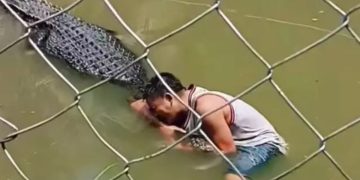The world lost some of its oldest known heritage recently when mining giant Rio Tinto set off charges in pursuit of a cache of iron ore in Western Australia, ABC News reported.
It was all fully legal and government-approved, but nevertheless, it played out in a tragic scenario that has the nation’s Puutu Kunti Kurrama people in mourning for the loss of a significant piece of their history.
To be fair, Rio Tinto did everything by the book and then some.

As ABC News reported, the company received government approval in 2013 to blast near the Juukan Gorge, having stated up front that it would likely impact the Juukan 1 and Juukan 2 rock shelters. Rio Tinto had worked with the PKK people for about a decade beforehand to that point, identifying sites with cultural significance and trying to avoid them where they could.
The two caves, however, were within about 11 meters of a significant iron ore deposit, the Sydney Morning Herald reported.
In 2014, after the government had signed off, Rio Tinto funded a mission to the caves to salvage any artifacts of significance that might be there.

In the process, archaeologists discovered several items that put the situation in new light.
Among them were a 4,000-year-old plaited hair belt that DNA linked to modern PKK and Pinikura peoples, as well as grinding and pounding stones, and a bone tool dating back about 28,000 years, both of which represent the earliest examples of such technology in Australia.
In a report due out later this year, archaeologists said the caves’ significance could not be overstated.

According to the Sydney Morning Herald, the archaeological team had hoped to continue excavations at the sites.
“What we found were some really important discoveries,” Dr. Michael Slack told ABC News. “This site was something special. It was a massive cave, it had such a rich cultural deposit, such an old occupation. And so significant in that respect that it’s one of those sites you only excavate once or twice in your career.”
And for all the caves meant to archaeologists, they meant that much more to their traditional owners.

“Our people are deeply troubled and saddened by the destruction of these rock shelters and are grieving the loss of connection to our ancestors as well as our land,” John Ashburton, chair of the Puutu Kunti Kurrama Land Committee, told ABC News .
“It saddens us that something that we have got a deep connection to has been destroyed,” added Burchell Hayes, a PKK traditional owner. “Traditionally we hand that [heritage] down to the next generation, but in this case we won’t have anything to show the next generation and to tell them stories about what has happened there and what’s been passed down from our ancestors.”
A delegation of traditional title holders from the PKK and Pinikura peoples had recently applied to visit the site.

However, they were informed it wouldn’t be possible as the charges had already been laid.
After learning that Rio Tinto was getting set to blast the site, the elders applied to have the detonation stopped or altered to limit damage to the site, but they were informed it would be unsafe to tinker with the charges at that point.
Ashburton acknowledged that Rio Tinto acted lawfully in blasting the sites.

However, he took issue with the “inflexible” regulatory system that did not take new information and new discoveries into account after providing assent for something that’s irreversible.
“We recognise that Rio Tinto has complied with its legal obligations, but we are gravely concerned at the inflexibility of the regulatory system,” Ashburton said.
As ABC News reported, changes to the nation’s cultural heritage legislation that would allow new information to be considered in such situations is due to be debated later this year.
h/t: ABC News , Sydney Morning Herald

















































